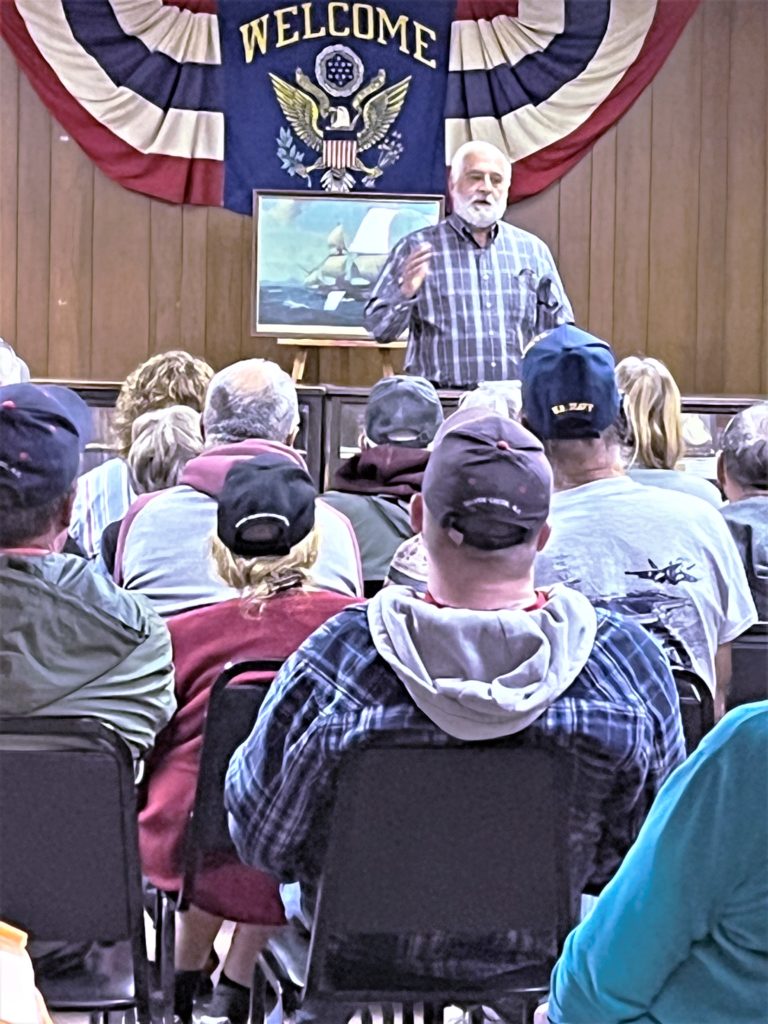Local Historian shares tale of disaster on Lake Erie

By Virginia Becker
A full house of local residents gathered at the Historical Center on September 22 to hear Louis Pelletter, Village of Silver Creek historian, share his research regarding the steamship George Washington. The ill-fated vessel burned on Lake Erie about three miles off the harbor at Silver Creek, NY.
Pelletter prefaced the horrific story by explaining that his journey in uncovering the facts was fraught with inconsistencies. He cited several examples of reports that did not agree. In particular, which way the ship was headed, was it her maiden voyage, what was the actual date, who was the captain, how many were on board, and how many perished? Ferreting out the true details of an event make the journey of the historian all the more interesting, if not at times frustrating, and also make for a fascinating presentation.
After much research with many sources, the truth of the event began to emerge. The George Washington was a side-wheeled wooden steamship built with a boiler in 1837-38 in Ashtabula, Ohio. This was an early age for ships powered by steam and not all the new technology had been worked out. On June 16, 1838, the ship was traveling west from Buffalo to Cleveland with Captain Brown in command and some estimated 80 to 100 passengers. Sometime between 2 a.m. and 3 a.m., it was discovered that the Washington was on fire, probably starting in the boiler. The attempt to point the ship towards shore was thwarted by the wheel rope steering mechanism. The ropes burned through thus leaving the ship uncontrollable and finally stranded. As an aside, Pelletter stated that the steering ropes in steamships were being replaced by iron rods. Had the iron rods been installed, the event might have had a different ending.
Pelletter explained that Silver Creek had a wharf built by Oliver Lee in the 1820s off Jackson Street. The harbor was deep enough at that time to allow lake ships to load and unload cargo. Someone on horseback alerted the people of the community to the fire, and several came to assist in the rescue using their own boats moored nearby or at the dock. The steamship North America was on the lake at the time and returned to assist as well. Meanwhile on the ship, passengers tried to escape the fire anyway they could. Some loaded onto a small onboard boat. As luck would have it, the ropes jammed. When it eventually slammed into the lake, some of the passengers spilled out. Others on the ship jumped of their own accord to escape burning to death, yet succumbed to the cold Lake Erie waters and drowned. Still others remained on the ship and were severely burned. The exact number of victims is not certain, but it’s been estimated that about 50 people died in the incident. Because the ship’s manifest and passenger list was lost to the fire, not everyone could be accounted for.
As with most tragedies, there was an investigation as to what went wrong and who was responsible. Some blamed the ship’s poor construction, others the owners and management or Captain Brown (who survived) and his crew. But in one rather weak rebuttal, it was stated that had the passengers remained calm, they all could have been saved.
Pelletter applied for a grant to purchase a historic plaque commemorating the tragedy of the steamship George Washington. He will place the plaque near the “Burning of the Steamship Erie” plaque at the George Borrello Park on Front Street in Silver Creek, N.Y.
After the presentation and questions, visitors remained to greet each other and share stories. Refreshments of cookies, brownies, pumpkin cake, and lemonade were served on the porch.
For greater details on this historic event and many more related facts about early Silver Creek, visit Louis Pelletter’s Facebook post at: https://www.facebook.com/2071493269600058/posts/the-tragic-end-of-the-steamship-george-washingtonby-louis-f-pellettersilver-cree/4939289689487054/ or by Googling “The Tragic End of the Steamship George Washington” by Louis F. Pelletter.